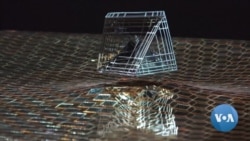Levitating objects and plastic boxes may not seem to have anything to do with landscape painting, but they are the contemporary take on an ancient Chinese art style called "shan shui hua" or mountain water painting.
Dating back more than 1,000 years, this style of landscape painting, which uses brush and ink, has evolved over time. The art form is evolving once again in an exhibit called "Lightscapes: Re-envisioning the Shanshuihua" at the Chinese American Museum in Los Angeles.
The goal of Nick Dong and Chi-Tsung Wu, the two artists in the exhibit, is to connect the new, digital generation to this traditional type of art and to capture its essence in a new way through modern technology.
The exhibit forces the viewer to slow down and experience a different world. That’s one of the objectives of the ancient masters of Chinese shan shui paintings.
Escape from reality
“Actually, it was for all these artists to create a world which they want to hide, avoid, escape from reality. So, they create a mountain (and) imagine they could live there,” said Dong, an artist born in Taiwan who now lives in Northern California.
Trained in both Chinese and Western art styles, Dong and Wu use experimental materials and light in the various art pieces in the exhibit.
In a contemporary approach to what’s real and what is not, one installation involves a slowly moving light directed at clear plastic boxes attached to a wall.
“If we see this through the light, through the different perspective, we could see there’s another world behind that,” Wu said about his installation called Crystal City.
That other world Wu referenced are shadows that look more real and solid than the actual plastic boxes. Wu said the art installation is symbolic of the modern digital age.
“We spend most of our time in our daily life, no matter to work or to our social life or our entertainment, all on this cyberspace,” he said.
That space is an escape for many people similar to the landscape paintings.
Philosophy and the spiritual
To capture the philosophical elements of the landscape painting, magnets are used to levitate objects to show that there is a force between everything in nature.
Another art piece in the exhibit is a take on one's relationship with the universe. To view Dong’s representation of heaven, one has to step into a room filled with mirrors from ceiling to floor. There is a stool in the middle of the room.
“We’re all searching. We’re all longing for growth, become better and, ultimately, good enough to go to heaven. So, in my mind, heaven is a place of selfless, so eventually once you’ve entered the installation, at first you’ll see a lot of your reflection. But once you sit down, you trigger the mechanism of the room. The mirror actually starts to reflect, and you yourself will disappear within the space. You vanish. All you have is this empty, wide-open space. For me, it’s the ultimate evolution,” Dong explained.
The art pieces in the exhibit are ways the artists hope the modern-day viewer will be able to experience what the ancient artists of the landscape paintings were trying to achieve.
“They (ancient scholars) were able to say, 'We’re seeking a spiritual outlet. We’re seeking a way to refine the spirit and refine the soul.' This work, today, it’s hard to have that experience with the traditional artwork because they’re such a contained device. You see them in a museum under glass, and they’re hard to approach,” said Justin Hoover curator of the Chinese American Museum, Los Angeles.
Contemporary artists hope their use of lighting and experimental materials will make an ancient art form more tangible and real in the 21st century.






